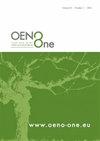门多萨土壤微生物组:葡萄栽培农业生态管理发展的微生物资源
IF 2.2
3区 农林科学
Q3 FOOD SCIENCE & TECHNOLOGY
引用次数: 0
摘要
根际微生物被认为是植物的延伸,代表着促进植物从周围环境中吸收营养的关键因素。因此,人们非常关注土壤微生物,因为在全球气候变化的情况下,土壤微生物被认为是提高作物恢复力的一个有前途的来源。为了探索两个气候和耕作历史截然不同的地区葡萄园及其周围干旱土壤中的细菌和真菌群落,进行了扩增子测序分析。具体而言,Santa Rosa(SR)位于一个通常被称为第一区的地区,其特征是低海拔(607 m.a.s.l.,Winkler V),而Gualtallary(G)位于Uco Valley区,一个高海拔(1245 m.a.s.l.,Winkleer III);两者都位于门多萨出产葡萄酒的地区。SR的特点是其悠久的种植历史,而G是最近种植的地区。采集表层土样品,并用于细菌和真菌群落特征。子囊菌门是真菌生物群落组成中的主要门(38-97%),而变形菌门是这两个地区最丰富的细菌门(26-34%)。此外,解释地区间微生物组差异的主要因素是碳氮比。Anaerolineae和Gammaproteobacteria是SR栽培土壤中一个独特的细菌类群。氮螺旋菌在SR未开垦土壤中含量较高,而根际菌在G未开垦土壤上含量不同。在功能分析方面,SR土壤表现出较高的硝化菌反硝化活性和葡萄糖相关代谢,而在G土壤中,细菌光合作用活性是一个差异特征。此外,放线菌在SR栽培土壤中的丰度较低,表明该门对葡萄作物实践的易感性较高。这些结果允许开发当地微生物资源及其对葡萄藤营养的贡献的假设模型,这对于制定葡萄藤管理建议以保护门多萨葡萄藤地区的土壤健康非常重要。本文章由计算机程序翻译,如有差异,请以英文原文为准。
Microbiome in soils of Mendoza: microbial resources for the development of agroecological management in viticulture
Rhizosphere microorganisms are considered an extension of plants, representing critical actors involved in the promotion of plant nutrient intake from the surrounding environment. Consequently, a great focus is being made on soil microorganisms since they are considered a promising source for crop resilience improvements under a global climate change scenario. To explore bacterial and fungal communities from arid soils in vineyards and their surroundings from two regions with very different climate and tillage histories, an amplicon sequencing analysis was performed. Specifically, Santa Rosa (SR) is in a region commonly known as the first zone, characterised by low altitude (607 m.a.s.l., Winkler V), while Gualtallary (G) is in the Uco Valley Zone, a region with high altitude (1245 m.a.s.l., Winkler III); both in the productive wine region of Mendoza. SR is characterised by its long cultivation history, while G is a recently cultivated region. Topsoil samples were collected and used for bacterial and fungal community profile characterisation. Ascomycota was the predominant phylum (38–97 %) in mycobiome composition, whereas Proteobacteria was the most abundant bacterial phylum (26–34 %) in both regions. Moreover, the main factor explaining microbiome differences between regions was the carbon-to-nitrogen ratio. Anaerolineae and Gammaproteobacteria were a distinctive bacterial class in SR-cultivated soils. Azospirillales were highly abundant in SR uncultivated soils, while Rhizobiales were differentially abundant in G uncultivated soils. Regarding functional analysis, soils from SR showed a higher denitrification activity of nitrifiers as well as glucose-related metabolism, while in G soils, bacterial photosynthesis activities were a differential trait. In addition, Actinobacteria abundance was lower in SR-cultivated soils, indicating a higher susceptibility of this phylum to grapevine crop practices. These results allow the development of hypothetical models of the local microbial resources and their contribution to grapevine nutrition, which is highly important to elaborate recommendations for grapevine management to preserve soil health in vine areas of Mendoza.
求助全文
通过发布文献求助,成功后即可免费获取论文全文。
去求助
来源期刊

OENO One
Agricultural and Biological Sciences-Food Science
CiteScore
4.40
自引率
13.80%
发文量
85
审稿时长
13 weeks
期刊介绍:
OENO One is a peer-reviewed journal that publishes original research, reviews, mini-reviews, short communications, perspectives and spotlights in the areas of viticulture, grapevine physiology, genomics and genetics, oenology, winemaking technology and processes, wine chemistry and quality, analytical chemistry, microbiology, sensory and consumer sciences, safety and health. OENO One belongs to the International Viticulture and Enology Society - IVES, an academic association dedicated to viticulture and enology.
 求助内容:
求助内容: 应助结果提醒方式:
应助结果提醒方式:


